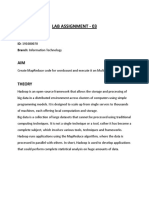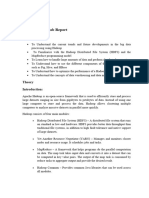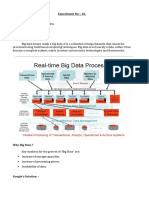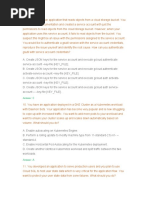Efficient Ways To Improve The Performance of HDFS For Small Files
Efficient Ways To Improve The Performance of HDFS For Small Files
Uploaded by
Yassine ZriguiCopyright:
Available Formats
Efficient Ways To Improve The Performance of HDFS For Small Files
Efficient Ways To Improve The Performance of HDFS For Small Files
Uploaded by
Yassine ZriguiOriginal Title
Copyright
Available Formats
Share this document
Did you find this document useful?
Is this content inappropriate?
Copyright:
Available Formats
Efficient Ways To Improve The Performance of HDFS For Small Files
Efficient Ways To Improve The Performance of HDFS For Small Files
Uploaded by
Yassine ZriguiCopyright:
Available Formats
Computer Engineering and Intelligent Systems
ISSN 2222-1719 (Paper) ISSN 2222-2863 (Online)
Vol.5, No.1, 2014
www.iiste.org
Efficient Ways to Improve the Performance of
HDFS for Small Files
Parth Gohil
Department of Computer Science and Engineering
Government College of Engineering,Modasa,Gujarat.
Tel: +91 9662123479 Email: er.parthgohil@gmail.com
Prof. Bakul Panchal
Department of Information Technology
L.D College of Engineering,Ahmedabad,Gujarat.
Tel: +91 9426436891 Email: bakul.panchal@gmail.com
ABSTRACT:Hadoop , an open-source implementation of MapReduce dealing with big data is widely used for short jobs that
require low response time. Facebook, Yahoo, Google etc. makes use of Hadoop to process more than 15
terabytes of new data per day. MapReduce gathers the results across the multiple nodes and return a single result
or set. The fault tolerance is offered by MapReduce platform and is entirely transparent to the programmers.
HDFS (Hadoop Distributed File System), is a single master and multiple slave frameworks. It is one of the core
component of Hadoop and it does not perform well for small files as huge numbers of small files pose a heavy
burden on NameNode of HDFS and decreasing the performance of HDFS. HDFS is a distributed file system
which can process large amounts of data. It is designed to handle large files and suffers performance penalty
while dealing with large number of small files. This paper introduces about HDFS, small file problems and
ways to deal with it.
Keywords: Hadoop; Hadoop Distributed File System; MapReduce; small files
1. INTRODUCTION
As data and work grow, it takes a longer time to produce results. To produce the result in timely manner,
one should start thinking big. A certain way is to carried out to spread the work across many computers i.e. one
needs to scale out. Data is classified as structured and unstructured data. Structured data uses a fixed layout (in
form of tables and rows) and unstructured data uses the data in the form of logs (no tables). MapReduce is a
programming model which is designed for processing large volumes of data in parallel[2]. It does so by dividing
the work into a set of independent tasks. MapReduce programs transform lists of input data elements into lists of
output data elements. The MapReduce data elements are immutable, i.e. they cannot be updated. The policy is to
place the file into HDFS once and can read the file 'n' number of times.
If in a mapping task you change an input (key, value) pair, it does not get reflected back in the input files;
communication occurs only by generating new output (key, value) pairs which are then forwarded by the
Hadoop system into the next phase of execution. Hadoop finds difficulty in running MapReduce jobs which
involve thousands of small files.
In this paper, we focus on the different efficient ways in which small files are handled in HDFS to improve
performance of it.
2. HADOOP
Big data is used to handle a large amount of data and it considers unstructured data into account. Facebook
is one of the best examples of big data. It is because it processes more than 15 terabytes of new data per day[2].
Say there is a machine having four I/O channels each with a throughput of 100 MB/sec and requires three hours
to read a 4 TB data set. With Hadoop, the same data set will be divided into smaller blocks (typically 64 MB)
and are distributed among many machines in the cluster via the Hadoop Distributed File System (HDFS)[2]. The
cluster machines have the capability of reading the data set in parallel and providing a much higher throughput
due to the degree of replication. A cluster of commodity machines is much cheaper than one high-end server.
The main challenge is to read-write the data or analyse the data. For this one requires a system that
supports Distributed File System (DFS). It is a method of storing and accessing files based in client/server
architecture. In it one or more central servers store files that can be accessed, with proper authorization rights,
by any number of remote clients in the network.
Hadoop provides a framework for supporting this and is written in Java Programming Language. Apache
Hadoop[1] is a software framework for distributed processing of large datasets across clusters of commodity
45
Computer Engineering and Intelligent Systems
ISSN 2222-1719 (Paper) ISSN 2222-2863 (Online)
Vol.5, No.1, 2014
www.iiste.org
computers using single programming model. Large datasets means that Terabytes or Petabytes of data is stored.
Commodity computers are that there is no need of high quality machine and a Single programming model i.e.
MapReduce is used. In MapReduce the application is divided into many small fragments of work, each of which
can execute or re-execute on any node in the cluster. It also provides a distributed file system (DFS) that stores
the data on the compute nodes, providing very high aggregate bandwidth across the cluster. DFS is designed so
that node failures are automatically handled by the framework. Hadoop streaming is a utility that comes with the
Hadoop distribution which allows writing map/reduce code in any language one wants to. This is a key feature
in making Hadoop more acceptable and attractive to use.
Companies using Hadoop are Yahoo, Google, Facebook, Amazon, IBM and Indian Adhar card System.
3. HDFS ARCHITECTURE
In this architecture, there are two main components of Hadoop namely (i) Hadoop Distributed File System
(HDFS) which is used for storage purpose (ii) Execution Engine i.e. MapReduce for processing.
Fig.1. HDFS Architecture
There are five main building blocks of Hadoop [7]. They are (i) NameNode (ii) DataNode (iii) Secondary
NameNode (iv) JobTracker (v) TaskTracker. NameNode is the master node on which the JobTracker runs and
DataNode is the slave node on which the TaskTracker runs. JobTracker and TaskTracker are the daemons i.e.
the process or the services running on background.
3.1 NameNode
It is the master of HDFS which directs the slave DataNode to perform the low-level I/O tasks. It keeps a
track of how the files are broken down into file blocks and which nodes are used to store those file blocks. The
metadata is maintained in the main memory of the NameNode to ensure fast access to the client, on read/write
requests. The NameNode is a single point of failure of your Hadoop cluster and this is the only negative aspect
to the importance of the NameNode.
3.2 DataNode
It is the slave node which is used to perform the work of the distributed filesystem such as reading and
writing HDFS blocks to actual files on the local filesystem. When one wants to read or write a HDFS file, the
file is broken into blocks and the NameNode on request from the client will tell the client that on which
DataNode each block resides in. Default block size is 64MB. Client communicates directly with the DataNodes
to process the local files corresponding to the blocks. A DataNode may also communicate with other DataNodes
to replicate its data blocks for redundancy using pipeline process.
3.3 Secondary NameNode (SNN)
It is an assistant daemon for monitoring the state of the NameNode. It performs periodic checkpoints. One
can restart the NameNode using the checkpoint in case of NameNode failure. Like the NameNode, each cluster
has one SNN, which resides on its own machine. Secondary NameNode is not a substitute for the NameNode.
3.4 Job Tracker
46
Computer Engineering and Intelligent Systems
ISSN 2222-1719 (Paper) ISSN 2222-2863 (Online)
Vol.5, No.1, 2014
www.iiste.org
Job tracker is the daemon on which the NameNode runs. Once one submits the code to the cluster, it
determines which files to process, assigns nodes to different tasks, and monitors all tasks as theyre running. In
case the tasks fail, the task is automatically re-launched by the JobTracker, possibly on a different node, up to a
predefined limit of retries. There is only one JobTracker daemon per Hadoop cluster which runs on a server as a
master node of the cluster.
3.5 TaskTracker
TaskTracker is the daemon on which the DataNode runs. It is responsible for executing the individual tasks
that the JobTracker assigns. Although there is a single TaskTracker per slave node, each TaskTracker can spawn
multiple Java Virtual Machines to handle many map or reduce tasks in parallel. The TaskTracker constantly
keeps on communicating with the JobTracker. In case the JobTracker does not receive a heartbeat from a
TaskTracker within a specified amount of time, it assumes that the TaskTracker has crashed and hence it
resubmits the corresponding tasks to other nodes in the cluster.
4. HDFS FEATURES
The following are the features of Hadoop Distributed File System:
i.
ii.
iii.
iv.
v.
Big data: Big Data is basically defined in term of the 'three V's': volume of data (size), velocity of data
(speed), and variety of data (type). It is basically a large volume of unstructured live data. Apache
Hadoop is an analytics tool that has been labelled 'big data'.
Large: A HDFS instance may consist of thousands of server machines, each storing part of the file
systems data
Replication: Each data block is replicated many times (default is 3)
Failure: Failure is the norm rather than exception
Fault Tolerance: Detection of faults and quick, automatic recovery from them is a core architectural
goal of HDFS.Namenode is consistently checking Datanodes
5. SMALL FILE PROBLEM
Storing large number of small files into HDFS is an overhead in terms of memory usage. Because every
file, directory and block in HDFS is represented as an object in the namenodes memory, each of which
occupies 150 bytes, as a rule of thumb. So 10 million files, each using a block, would use about 3 gigabytes of
memory[11]. Further, the size of main memory in NameNode restricts the number of files that can be stored into
HDFS.
HDFS does not work well with lots of small files because of the following reasons[8]:
(i) Each block holds a single file, and hence a lot of small blocks (smaller than the configured block size).
Reading these entire blocks one by one consumes a lot of time.
(ii) It is the duty of the NameNode to keep a track of each file and each block and store this data into memory.
More memory space is occupied by a large number of files.
6. WAYS TO DEAL WITH SMALL FILE PROBLEM
In order to deal with small file problem, following approaches is discussed in this section.
6.1 HAR [11][14]
HAR stands for Hadoop Archive. It merges small files into large file so as to access the original files in
parallel transparently (without expanding the files) and efficiently. HAR files work by building a layered file
system on top of HDFS. At the current time HARs are probably best used purely for archival purposes.
47
Computer Engineering and Intelligent Systems
ISSN 2222-1719 (Paper) ISSN 2222-2863 (Online)
Vol.5, No.1, 2014
www.iiste.org
Fig.2 Layout of HAR File
There are certain disadvantages also of HAR files. They are as follows:
i.
ii.
Reading through files in HAR is slow as compared to reading the files in HDFS. This is because each
HAR file access requires two index file reads as well as the data file read.
Inspite of the fact that HAR files are used as the input to MapReduce, no special mechanism allows the
maps to operate over all the files in the HAR residing on a HDFS block.
6.2 Sequence File[11]
In this technique, the filename is used as a key and its contents as the value. A number of files are put in a
single Sequence file and then processing of such files are done using a MapReduce technique. A program can be
written for the same. Sequence files can be split and is it considered to be one of the advantage of it. MapReduce
can break them into chunks and operate on each chunk independently. The sequence files allows compression.
Fig.3 SequenceFile File Layout
Few additional features of SequenceFiles are as follows:
i.
ii.
iii.
Converting existing data to SequenceFile is slow. It is perfectly possible to create a collection of
SequenceFiles in parallel. As a possible solution its best to design data pipeline to write the data at
source direct into a SequenceFile, if possible, rather than writing to small files as an intermediate step.
Unlike HAR files there is no way to list all the keys in a SequenceFile, short of reading through the
whole file.
This technique is Java-centric.
6.3 Consolidator[10]
It takes the records containing files belonging to the same logical file & merges the files together into larger
files. It is possible but not practical to merge all the files into a one large file as then it would be a terabytes
sized file. A longer time is taken to run such a huge file. Hence Consolidator has a parameter for "desired file
size" where user can define the maximum file size of a merged file. In this way Consolidator balances its speed
with the desired size of files. "Desired file size" can be set to some multiples of the HDFS block size so that the
input splits are larger to optimize for locality.
6.4 HBase[10]
Fig.4 MapFile File Layout
48
Computer Engineering and Intelligent Systems
ISSN 2222-1719 (Paper) ISSN 2222-2863 (Online)
Vol.5, No.1, 2014
www.iiste.org
If you have lots of small files, then, depending on the access pattern, a different type of storage might be
more appropriate. HBase stores data in MapFiles (indexed SequenceFiles), and is a good choice if you need to
do MapReduce style streaming analyses with the occasional random look up. If we are storing lots of small files
then HBASE provides a better interface for faster look up of files.
7. CONCLUSION
HDFS is designed to store large files and suffers performance penalty while storing large
amount of small files and performing analysis of them. The number of mappers are increased for too many
small files and high memory usage is caused by huge numbers of files. Small file problems are solved by given
approaches. Each of these approach applicable in different context which improves the efficiency of access to
small files in HDFS
References
[1]
[2]
[3]
[4]
[5]
[6]
[7]
[8]
[9]
[10]
[11]
[12]
[13]
[14]
Hadoop official site, http://hadoop.apache.org/core/.
Shvachko, K.; Hairong Kuang; Radia, S.; Chansler, R., "The Hadoop Distributed File System," Mass Storage Systems and
Technologies (MSST), 2010 IEEE 26th Symposium on , vol., no., pp.1,10, 3-7 May 2010
SlideShare site, http://www.slideshare.net/.
Hadoop archives, http://hadoop.apache.org/common/docs/current/hadoop_archives.html.
Sequence File Wiki, http://wiki.apache.org/hadoop/SequenceFile.
Chuck Lam, Hadoop in Action, Manning Publications,2011
HDFS. http://hadoop.apache.org/hdfs/, 2010
http://pastiaro.wordpress.com/2013/06/05/solving-the-small-files-problem-in-apache-hadoop-appending-and-merging-in-hdfs/
Doug Cutting, Tom White. Hadoop: The Definitive Guide [M]. O'Reilly Media, Yahoo! Press,2011
Small file problem, http://snowplowanalytics.com/blog/2013/05/30/dealing-with-hadoops-small-files-problem/
Tom White, The Small Files Problem. http://www.cloudera.com/blog/2009/02/the small files problem, 2009.
Grant Mackey, Saba Sehrish, Jun Wang,"Improving Metadata Management for Small Files in HDFS" IEEExplore,2009
B. Dong, J. Qiu, Q. Zheng, X. Zhong, J. Li, Y. Li. A Novel Approach to Improving the Efficiency of Storing and Accessing
Small Files on Hadoop: A Case Study by PowerPoint Files. In Proceedings of IEEE International Conference on Services
Computing, Miami, Florida, USA, July 2010, pp. 65
Vaibhav Gopal Korat, Kumar Swamy Pamu, " Reduction of Data at Namenode in HDFS using harballing T echnique"
International Journal of Advanced Research in Computer Engineering & Technology,Volume 1, Issue 4, June 2012
49
You might also like
- Spectrum Virtualize For Public Cloud L2 Seller Presentation - 2020-Feb-05Document58 pagesSpectrum Virtualize For Public Cloud L2 Seller Presentation - 2020-Feb-05richieNo ratings yet
- 02 Unit-II Hadoop Architecture and HDFSDocument18 pages02 Unit-II Hadoop Architecture and HDFSKumarAdabalaNo ratings yet
- HADOOPDocument19 pagesHADOOPucebittrichy2020No ratings yet
- Unit-2 Hadoop HDFS HadoopecosystemDocument25 pagesUnit-2 Hadoop HDFS Hadoopecosystemsisodiyaa853No ratings yet
- Big Data Analytics AssignmentDocument7 pagesBig Data Analytics AssignmentDevananth A BNo ratings yet
- 4 UNIT-4 Introduction To HadoopDocument154 pages4 UNIT-4 Introduction To HadoopPrakashRameshGadekarNo ratings yet
- BDA- UNIT 3Document41 pagesBDA- UNIT 3AnonymousNo ratings yet
- Unit 5 - Big Data Ecosystem - 06.05.18Document21 pagesUnit 5 - Big Data Ecosystem - 06.05.18Asmita GolawtiyaNo ratings yet
- NYOUG Hadoop PresentatonDocument47 pagesNYOUG Hadoop PresentatonV KalyanNo ratings yet
- bda final sem 7Document120 pagesbda final sem 7himanshidvyasNo ratings yet
- Compusoft, 2 (11), 370-373 PDFDocument4 pagesCompusoft, 2 (11), 370-373 PDFIjact EditorNo ratings yet
- Prepared By: Manoj Kumar Joshi & Vikas SawhneyDocument47 pagesPrepared By: Manoj Kumar Joshi & Vikas SawhneykavithaNo ratings yet
- Hadoop PDFDocument4 pagesHadoop PDFRavi Joshi0% (1)
- Hadoop PresentatonDocument47 pagesHadoop PresentatonJhumri TalaiyaNo ratings yet
- UNIT 5 CombinedDocument13 pagesUNIT 5 Combinedparidhiagarwal129No ratings yet
- BDA NotesDocument25 pagesBDA Notesmrudula.sbNo ratings yet
- Apache Hadoop: Developer(s) Stable Release Preview ReleaseDocument5 pagesApache Hadoop: Developer(s) Stable Release Preview Releasenitesh_mpsNo ratings yet
- Lovely Professional University (Lpu) : Mittal School of Business (Msob)Document10 pagesLovely Professional University (Lpu) : Mittal School of Business (Msob)FareedNo ratings yet
- BDA Lab Assignment 3 PDFDocument17 pagesBDA Lab Assignment 3 PDFparth shahNo ratings yet
- BDA Lab Assignment 2Document18 pagesBDA Lab Assignment 2parth shahNo ratings yet
- A Review On HADOOP MAPREDUCE-A Job Aware Scheduling TechnologyDocument5 pagesA Review On HADOOP MAPREDUCE-A Job Aware Scheduling TechnologyInternational Journal of computational Engineering research (IJCER)No ratings yet
- Module 2 CNDocument23 pagesModule 2 CNmksaravanamk1No ratings yet
- BDA Unit-3Document47 pagesBDA Unit-3Jaya PrakashNo ratings yet
- Big Data Assignment 1Document6 pagesBig Data Assignment 1Ashutosh SahniNo ratings yet
- Intro Hadoop Ecosystem Components, Hadoop Ecosystem ToolsDocument15 pagesIntro Hadoop Ecosystem Components, Hadoop Ecosystem ToolsRebecca thoNo ratings yet
- Big Data Module 2Document23 pagesBig Data Module 2Srikanth MNo ratings yet
- Compare Hadoop & Spark Criteria Hadoop SparkDocument18 pagesCompare Hadoop & Spark Criteria Hadoop Sparkdasari ramyaNo ratings yet
- Hadoop: A Report Writing OnDocument13 pagesHadoop: A Report Writing Ondilip kodmourNo ratings yet
- Cloud ComputingDocument19 pagesCloud ComputingAfia FaryadNo ratings yet
- U-3 Big DataDocument23 pagesU-3 Big Datakanteti.srisandhyaNo ratings yet
- CC Unit 5Document43 pagesCC Unit 5prassadyashwinNo ratings yet
- Introduction To HadoopDocument5 pagesIntroduction To HadoopHanumanthu GouthamiNo ratings yet
- Bigdata Unit IVDocument29 pagesBigdata Unit IVCS BCANo ratings yet
- HADOOP and PYTHON For BEGINNERS - 2 BOOKS in 1 - Learn Coding Fast! HADOOP and PYTHON Crash Course, A QuickStart Guide, Tutorial Book by Program Examples, in Easy Steps!Document89 pagesHADOOP and PYTHON For BEGINNERS - 2 BOOKS in 1 - Learn Coding Fast! HADOOP and PYTHON Crash Course, A QuickStart Guide, Tutorial Book by Program Examples, in Easy Steps!Antony George Sahayaraj100% (1)
- Unit II Big DataDocument27 pagesUnit II Big Datarohitmarale77No ratings yet
- Module 1Document66 pagesModule 1Anusha KpNo ratings yet
- Fbda Unit-3Document27 pagesFbda Unit-3Aruna ArunaNo ratings yet
- Hadoop: A Seminar Report OnDocument28 pagesHadoop: A Seminar Report OnRoshni KhairnarNo ratings yet
- Haddob Lab ReportDocument12 pagesHaddob Lab ReportMagneto Eric Apollyon ThornNo ratings yet
- NguyenNgocMinhKhue 20211124Document5 pagesNguyenNgocMinhKhue 20211124Huỳnh Lý Minh ChươngNo ratings yet
- Big Data Lecture PresentationDocument28 pagesBig Data Lecture Presentationzioncalvin9No ratings yet
- Hadoop EcosystemDocument7 pagesHadoop EcosystemKhushi PandeyNo ratings yet
- Untitled DocumentDocument5 pagesUntitled Documentmonisha.aidsNo ratings yet
- Wa0002.Document32 pagesWa0002.Lakkarsu PoojithaNo ratings yet
- Big Data Analytics – Unit 4Document32 pagesBig Data Analytics – Unit 4Prabha JoshiNo ratings yet
- Unit IIIDocument86 pagesUnit IIIFarhan SjNo ratings yet
- BDA ManualDocument57 pagesBDA Manualkrathodfe2022No ratings yet
- Big Data Unit 2Document31 pagesBig Data Unit 2Nazima BegumNo ratings yet
- Top Hadoop Interview Q&ADocument25 pagesTop Hadoop Interview Q&AP vishnuNo ratings yet
- BDA Lab Assignment 4 PDFDocument21 pagesBDA Lab Assignment 4 PDFparth shahNo ratings yet
- BDA Mod2@AzDOCUMENTS - inDocument64 pagesBDA Mod2@AzDOCUMENTS - inramyaNo ratings yet
- Big Data - Unit 2 Hadoop FrameworkDocument19 pagesBig Data - Unit 2 Hadoop FrameworkAditya Deshpande100% (1)
- Bda Bi Jit Chapter-4Document20 pagesBda Bi Jit Chapter-4Araarsoo JaallataaNo ratings yet
- Module-2Document23 pagesModule-2rashmita kNo ratings yet
- Module - 2 HalfDocument12 pagesModule - 2 Halfs8143152No ratings yet
- Technical SeminarDocument32 pagesTechnical SeminarSda SdasdNo ratings yet
- CC Unit 5 NotesDocument30 pagesCC Unit 5 NotesHrudhai SNo ratings yet
- Syllabus:: Introduction To Hadoop (T1)Document23 pagesSyllabus:: Introduction To Hadoop (T1)sanishwin2002No ratings yet
- IMTC634_Data Science_Chapter 13Document16 pagesIMTC634_Data Science_Chapter 13msmakkar.chief19No ratings yet
- Neal Davis Cheat SheetDocument3 pagesNeal Davis Cheat SheetSam100% (1)
- Azure Resume PointDocument2 pagesAzure Resume PointSatishNo ratings yet
- Simulado Az900Document160 pagesSimulado Az900Giovanna GeorgettiNo ratings yet
- Career Summary:: AWS Cloud ArchitectDocument5 pagesCareer Summary:: AWS Cloud ArchitectjohnsonkkuriakoseNo ratings yet
- CLOUD COMPUTING FinalDocument17 pagesCLOUD COMPUTING FinalYadnesh Pujare0% (1)
- Aspnet CoreDocument1 pageAspnet CorekwintcomNo ratings yet
- Solving Storage GatewayDocument1 pageSolving Storage GatewayAdarsh SrivastavaNo ratings yet
- 1 AwsDocument30 pages1 AwsAslam AnsariNo ratings yet
- Unit-5 FinalDocument19 pagesUnit-5 FinalMadhu MitaNo ratings yet
- Azure Mock Test1Document14 pagesAzure Mock Test1asbsfgNo ratings yet
- Project Title: Napster-Style Peer-To-Peer File Sharing System Output FileDocument9 pagesProject Title: Napster-Style Peer-To-Peer File Sharing System Output FileputinNo ratings yet
- Serverless ComputingDocument10 pagesServerless Computingnandubinoy92No ratings yet
- Kubernetes On AWS (Using Amazon EKS) : Akash Agrawal - July'27 2019Document24 pagesKubernetes On AWS (Using Amazon EKS) : Akash Agrawal - July'27 2019Dodo winyNo ratings yet
- Map Reduce Daemons: - Job Tracker - Task TrackerDocument14 pagesMap Reduce Daemons: - Job Tracker - Task TrackerLord DrawnzerNo ratings yet
- Cloud Computing MCQsDocument7 pagesCloud Computing MCQsmennasolimanali2No ratings yet
- M4 - Cloud ComputingDocument18 pagesM4 - Cloud ComputingPriybrat SharmaNo ratings yet
- HTTP - Web Caching and Conditional RequestDocument12 pagesHTTP - Web Caching and Conditional RequestChaerul AnamNo ratings yet
- Cordero 16.5.3Document9 pagesCordero 16.5.3Alliana Hira CorderoNo ratings yet
- Answer: CDocument21 pagesAnswer: CJose Garcia HerreraNo ratings yet
- Iot QBDocument2 pagesIot QBpriyaNo ratings yet
- Storage Patterns-KubernetesDocument34 pagesStorage Patterns-KubernetesManish Malhotra100% (3)
- OSS2019 HS k8sNativeInfra OperatorFor5GedgeDocument32 pagesOSS2019 HS k8sNativeInfra OperatorFor5GedgeRamon CuevasNo ratings yet
- SAP B1 CCC Solution: Technical DatasheetDocument2 pagesSAP B1 CCC Solution: Technical DatasheetWilliams CastilloNo ratings yet
- MCQs For AWSDocument3 pagesMCQs For AWSHari Babloo100% (1)
- Cloud Computing QuestionsDocument6 pagesCloud Computing QuestionsvivekNo ratings yet
- Team Members:-: 1. Rashmi Konnur 2. Rashmi M.S 3. Roopali GhodkeDocument17 pagesTeam Members:-: 1. Rashmi Konnur 2. Rashmi M.S 3. Roopali GhodkeprabhureshmaNo ratings yet
- 0318AM2DT101 Welcome To Dynatrace Without NotesDocument14 pages0318AM2DT101 Welcome To Dynatrace Without NotesSwarup PatraNo ratings yet
- WASE 2021 Cloud Computing Handout - S2 - 23Document25 pagesWASE 2021 Cloud Computing Handout - S2 - 23swathi spNo ratings yet
- CC Unit-5Document19 pagesCC Unit-5Kanduri shirisha GoudNo ratings yet

























































































